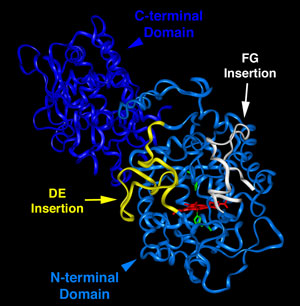 Improvement in the activity and usefulness of an existing enzyme or creation of a new enzyme activity by making suitable changes in its amino acid sequence is called Enzyme Engineering. When this approach is used to modify the properties of any protein, whether enzyme or nonenzyme, it is termed as protein engineering. Since enzymes are proteins, enzyme engineering is a part of the larger activity of protein engineering. Enzyme engineering utilizes r-DNA technology to introduce the desired changes in amino acid sequences of enzymes. In addition, the level of production of an enzyme may be increased by introducing more copies of the gene into the concerned organism.
Improvement in the activity and usefulness of an existing enzyme or creation of a new enzyme activity by making suitable changes in its amino acid sequence is called Enzyme Engineering. When this approach is used to modify the properties of any protein, whether enzyme or nonenzyme, it is termed as protein engineering. Since enzymes are proteins, enzyme engineering is a part of the larger activity of protein engineering. Enzyme engineering utilizes r-DNA technology to introduce the desired changes in amino acid sequences of enzymes. In addition, the level of production of an enzyme may be increased by introducing more copies of the gene into the concerned organism.OBJECTIVES OF ENZYME ENGINEERING
The chief objective of enzyme engineering is to produce an enzyme that is more useful for industrial and other applications. The various properties of an enzyme that may be modified to achieve this objective are as follows :-
- Improved kinetic properties.
- Elimination of allosteric regulation.
- Enhanced substrate and reaction specificity.
- Increased thermostability.
- Alteration in optimal pH.
- Suitability for use in organic solvents.
- Increased/decreased optimal temperature.
PRINCIPLES OF ENZYME ENGINEERING
The structure and function of an enzyme molecule, for that matter of any protein molecule, are chiefly determined by its amino acid sequence, i.e, its primary structure. Therefore, any change in the properties of an enzyme is always reflecte
d in its primary structure. Conversely, a change in the amino acid sequence should alter the properties of the enzyme. But, this is not always the case because the enzymatic properties, etc. are changed only when amino acid changes are introduced in certain critical regions of the protein. Therefore, it is of great importance to know the critical regions for the various functions of an enzyme, and to be able to predict the effect of specific amino acid changes in these areas on the various functions. However, the present knowledge of the relationships between amino acid sequences, 3D structure of protein and properties of enzymes, obtained from a large database is only partially operative. It allows an explanation of the changes in structure and function on the basis of the changes in amino acid sequence, but it does not allow a dependable prediction of the influences of specific amino acid changes on the structure and function of the enzymes.
It may, however, be reasonable to anticipate that as more elaborate databases and improved softwares become available, it should become possible to predict with a far greater confidence the structural and functional changes in enzymes produced by the specified changes in their amino acid sequences. The effectiveness of enzyme engineering will be greatly enhanced then, and this activity may have a tremendous influence on enzyme technology.
STEPS IN ENZYME ENGINEERING
The strategies for enzyme engineering and their theoretical considerations are quite involved. The steps involved in enzyme engineering are briefly described in simple terms :-
- The first step consists of isolation of the concerned enzyme and determination of its structure and properties. Both amino acid sequence and the 3D structure are usually obtained from X-ray diffraction, nuclear magnetic resonance (NMR), etc.
- The data so obtained are analyzed together with the database of known and putative structural effects of amino acid substitutions on enzyme structure and function. Molecular modelling is performed to determine a possible change in amino acid sequence for the desired improvement in the structure/function of an enzyme.
- The next step consists of constructing a gene that will encode the amino acid sequence specified at the end of step 2. This is best achieved by isolation and cloning of the endogenous gene encoding the concerned enzyme, and using this gene for site directed mutagenesis.
- Once the appropriated gene is constructed, it is introduced and expressed in a suitable host, e.g E.coli.
- The recombinant or mutant enzyme so produced is isolated, purified and used for determination of its structure and properties. The information so obtained is added to the database. If the enzyme structure and function are not altered as desired, the next cycle of experimentation (step 2-5) is undertaken.


No comments:
Post a Comment